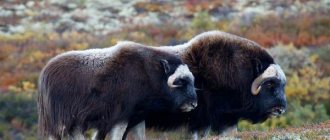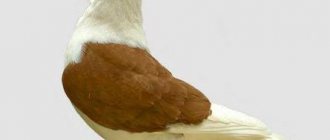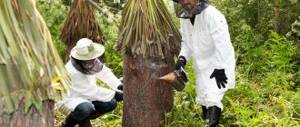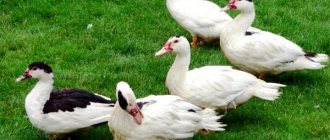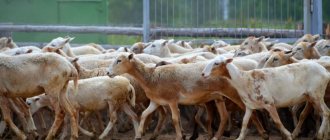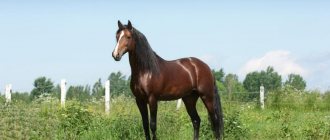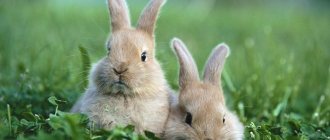- Wild animals
- >>
- Birds
The gray partridge is a small wild bird similar in size to the common domestic chicken. It has a muted gray-blue color with characteristic bright spots and a variegated pattern. This is a very common species of the genus of partridges, having a wide habitat. Wild chickens, as they are often called, have very nutritious and pleasant-tasting meat, which makes them a favorite subject of hunting not only for humans, but also for a large number of wild animals and birds.
The partridge is a bird that does not like to fly
The partridge is a well-known, widespread bird. Its name in all Slavic languages means a bird similar to a chicken. It inhabits Eurasia and was introduced to America. Hunters took care of transporting the bird to the American continent. It is they who show increased interest in this little-remarkable bird.
World culture has not ignored the partridge. An ancient Greek myth tells about the unseemly act of the ambitious architect Daedalus. He threw off a cliff a student who surpassed him in skill. But the young man did not die. Athena turned him into a partridge. Remembering this fall, partridges do not like to fly high and stay on the ground most of the time.
Description and features
The partridge is most easily described as a small chicken with motley colors. Its weight is 500-700 grams, and its length reaches 40 cm. The round body is supported by strong legs. Males and females have no spurs on their legs.
The general color scheme depends on the habitat and can be brown, brown, red, almost white. The feather cover is not evenly colored; there are streaks of different sizes and colors. The coloring of the bird suggests that the main defense strategy is camouflage.
Birds molt annually. This happens in the middle of summer. Females molt after finishing hatching their offspring. The largest flight feathers fall out first. By the end of summer, the main feathers are completely renewed. In autumn it’s the turn of contour feathers. By the beginning of winter, molting ends.
The white partridge has a pronounced seasonal difference in color . Winter cover is white. Except for some tail feathers. They are black. The rest of the time they are brown, red, with a white lower body.
Sexual dimorphism is manifested in the size of the bird: males are larger. Bettas have slightly brighter colored feathers. Externally, the birds of both sexes are so similar that only a specialist will be able to recognize whether the partridge in the photo is male or female.
Kinds
Partridges are a whole genus of birds that goes by the name Perdix. The genus belongs to the pheasant family. Turkeys, pheasants, and peacocks are related to partridges. guinea fowl, black grouse, that is, all chicken-like animals.
Most are classified in the pheasant family, partridge subfamily:
- The gray partridge is a species that includes 8 subspecies. Its taxonomic name is Perdix perdix. This is the most common partridge.
- The Tibetan partridge breeds in Central Asia. The species contains three subspecies. The scientific name of the species is Perdix hodgsoniae.
- Bearded partridge - looks like a gray partridge. Breeds in Siberia and Manchuria. The species is divided into two subspecies. The system name is Perdix dauricae.
- Chukar or stone partridge is predominantly gray in color with an ashy tint. The beak and paws are red.
- The desert partridge's plumage color is very similar to the chukar partridge, but has a pink tint. The plumage on the wings consists of black and white stripes.
- Bush partridge. A medium-sized bird with a brown color, with mottled plumage and small black, brown and cream spots on the sides and a brown back.
- Bamboo partridge. Small in size with pronounced sexual dimorphism. Variegated plumage in black, brown and cream colors.
- Shportsevaya. It has gray-brown plumage; the male has a bright color with small ripples that extend to the crest. There are spurs on the paws.
- The snowy partridge is feathered with black and white stripes up to the head. The beak is red.
- Madagascar. Endemic to the island, the bird itself is very large, females are mottled gray, males are larger with brighter plumage.
- Crowned or tufted partridge. The bird has an unusual color. The body is almost black with blue in males and green in females. There is a crest on the head.
For the most common gray partridge, natural nesting areas are all of Europe and Western Asia. This species has been introduced to other continents. Became widespread in Canada, the United States, South Africa, Northern Australia and Tasmania.
Subfamily of grouse, genus of white partridges:
- White partridge. In summer it is reddish-gray, but most of it is white, the eyebrows are scarlet. In spring it is red-brown, and the rest of the plumage is snow-white. In total, the bird changes plumage 3-4 times a year
- Tundra. The plumage of the male is distinguished by individual black-brown feathers on the head and shoulders. In summer it is brighter gray with stripes and spots. In winter they are white, the male has a black stripe across the eyes, the female does not have it.
- White-tailed, plumage like a white partridge, the difference is the white tail.
Lifestyle and habitat
For the main part of the year, birds stay in groups, small flocks, which often form around an unbroken brood. Collectivism is characteristic of group members. Birds survive the cold nights by huddling together. During flock feeding and daytime rest, one or two birds remain on duty and monitor the situation.
Partridges are sedentary birds. Their flocks sometimes change nesting territories. The reason for migration may be overpopulation of the area. This happens when numerous offspring are successfully raised.
The harsh winter forces us to hit the road. Partridges living in mountainous areas like to settle in the lowlands for the winter. Development of territories and human economic activities also force birds to wander.
Partridges do not like to fly. They spend most of their time on the ground. They take to the air only in case of danger. Not the best aerodynamic qualities are confirmed by the noise that accompanies their takeoff. When climbing and in flight, fast and sonorous strokes alternate with gliding.
The ability to fly, run quickly on the ground and hide well does not provide partridges with safety. All predators, from domestic cats to foxes and wolves, scour the fields in search of nests and flocks of partridges. Feathered aggressors - hawks, buzzards, harriers - are no less dangerous than ground-based ones.
In addition to predators, winter tests the viability of partridges. In places with mild winters and little snow, partridges live in flocks. They are located near winter fields, along the banks of reservoirs, in thickets of bushes. The flock manages to feed itself from a territory of 1 square meter. km.
During snowless winters, partridges gather in a dense group to spend the night. They hug each other closely. They form a circle of birds with their heads pointing outward. This configuration allows all individuals to take off at once in case of alarm.
In the event of a snowy winter, each bird is housed separately. Spends the night in a snow chamber. There have been cases when partridges disappeared into the snow after flying. They made passages and arranged places to spend the night in the snow.
Cold winters, dry summers, and terrestrial and avian predators are serious existential threats. Nature has found a way: the partridge bird wins its place in the sun through fertility and the rapid maturation of its offspring.
Chukar bird: care and breeding
Until recently, the chukar or mountain chicken could only be found in zoos. This subspecies of partridge is found in the mountainous regions of the Caucasus. This brightly colored bird is rarely seen in the European part of the country. Chukars are usually bred near their natural habitat.
Asian chukar
In the wild, a female chukar lays and incubates up to 15 eggs. In captivity, the number can be increased to 60 eggs. But the female will not hatch the eggs, although she can build a nest. To hatch chicks you will have to use an incubator. This is one of the reasons why this subspecies of partridge is rarely in demand among breeders. Poultry is bred mainly for aesthetic pleasure, as well as for meat.
Be sure to read:
10 popular types of poultry to keep in a cage at home
Food for chukars is the same as for poultry. However, partridges require more protein than regular chickens. Compound feed intended for broiler breeds is used as an additive.
Nutrition
Partridges are happy with a vegetarian diet. Grains of cultivated cereals, spring and winter, are an essential part of bird nutrition. Greens, young shoots and roots, and weed seeds supplement the diet. The seeds and fruits of trees, even birch catkins, are actively consumed by birds.
Birds' diet includes insects. They are especially abundant when inspecting plowed fields. In winter, partridge often moves closer to human habitation. On the one hand, the number of threats to her life increases. On the other hand, there are chances to feed themselves near elevators and granaries.
The black partridge is in danger of extinction
Disruption of the natural food chain has negatively impacted the black partridge population. The use of pesticides in agriculture has led to the extinction of large numbers of insects, putting the black partridge and some other bird species that depend on these insects in danger. This was reported by The News International.
The bird's diet consists of seven groups of insects, but now black partridges are increasingly forced to eat dead insects and seeds poisoned by pesticides. This is indicated by studies of bird feces.
The black partridge is known for its high-pitched chirping calls. Previously, birds lived in agricultural fields and forests. The black partridge's habitat covers the lowland tropical forests of the Malay Peninsula, Borneo, Sumatra and Southeast Asia. The black partridge is listed as a “vulnerable species” on the International Union for Conservation of Nature and Natural Resources (IUCN) Red List.
The black partridge is still a little-studied bird species. According to the IUCN, its population is rapidly declining and amounts to approximately 10-19 thousand individuals.
Among the main threats facing the black partridge, in addition to the use of pesticides in agriculture, IUCN experts highlight habitat loss due to deforestation and clearing of forests for rubber and oil palm plantations. The island of Borneo lost 25% of its forest area between 1985 and 1997, according to the IUCN.
According to The News International, a safe area for birds is, for example, the Nara Valley in Pakistan (Sindh province). This territory is under protection; local leaders support a ban on hunting here. Residents of the region follow these rules. Another safe area for black partridges is the Indus River basin in South Asia. Local farmers use old farming methods without the use of chemicals. This helps protect black partridges from the food crisis. However, another threat to the lives of birds may be the effects of climate change. Their effect on black partridge has not yet been studied.
To protect this valuable bird species, conservation groups advocate reducing the use of agricultural chemicals in black grouse habitats.
A separate area of work should be the dissemination of information among the local population about the value of the species to reduce the risks of poaching and the use of black partridges as pets due to their sonorous chirping. Material provided by the “+1” project.
Reproduction and lifespan
In the Northern Hemisphere, in areas with a temperate climate, the mating season begins in February. Males are becoming more active. They select sites for future nests. They begin to talk. Mating behavior consists of performing displaying poses, movements and sounds.
The pairing is done slowly. Partners who created an alliance last season and survived until the new spring most often form a couple again. The initiator in choosing a partner is the female.
The choice is not always final. Before the pair has time to form, it breaks up and the female chooses a new partner. In a flock, some males may be left without a mate. They join other groups of birds. Where the selection process is not completed.
After the initial formation of a pair, the initiative passes to the male. He takes care of the inviolability of the territory where the nest is supposed to be built. Arranges battles with competitors. Caring for the female. At this time she is building a very simple nest. In fact, this is a hole in the ground in a shaded place, which has the shape of a bowl with a diameter of 17-20 cm, a depth of 5-8 cm and is covered with dry grass.
Pairing and courtship takes about a month. Birds begin to mate starting in April. Copulation ends with clutch. The partridge lays from 10 to 18 eggs. Ornithologists have recorded cases of clutches consisting of 25 or more pieces. Partridge eggs correspond to the size of the bird: the long side is 4 cm, the short side is 3 cm.
The female does the incubation. Incubation ends after 23-26 days. The chicks emerge almost simultaneously, within a few hours. The offspring are ready to move immediately after emergence. The mother leads the chicks away from the birthplace. A male joins the brood. After an hour, the family finds itself 100-200 meters from the nest and never returns to it.
After a week, the chicks begin to take flight, and after two weeks they begin to fly long distances. Despite the rapid maturation, the brood, as an association, persists until autumn, and sometimes until winter. Can serve as a base group for creating a new flock.
Partridge hunting
Despite the small size of the bird and not very complex methods of tracking it, partridge hunting is a popular hobby. Two types of hunting are common: with a dog and from the approach.
In both cases, the hunter takes into account the partridge's daily routine. After spending the night, the birds go to watering or for morning fattening. Partridges love to feed in fields from which grains, buckwheat or millet have been harvested. In the middle of the day they immediately rest on the field or fly off to hide in the tall grass and weeds. In the afternoon they feed again, after which they go to spend the night.
In Europe, there is a tradition of collective partridge hunting, in which the dog only searches for and brings up the shot game. Usually such bird shootings are crowded and noisy. Many shots bring many trophies.
In Russian tradition, partridge hunting involves two people: a man and a dog. Playing the title role, the cop must show all her skills. She explores the territory in large zigzags. Sensing a bird, he makes a stance. At the hunter's command, it raises a flock. Partridges take off noisily. An unconfused hunter can get well-deserved trophies at this moment.
Not the entire flock can take off. A few individuals may hesitate and rise later. Therefore, the gun must be reloaded after the first shots. Despite the shots, the slightly frightened birds do not fly far and can land in the grass half a kilometer from the hunter. After letting them calm down, you can continue searching for and shooting them.
The dog is needed not only to detect and lift the bird onto the wing. Without it, wounded animals cannot be found. Hunting partridges without a dog can only be effective in places where there is a lot of this bird. It is advisable to hunt from the approach in the snow. Partridges who love to run will show with their tracks where to look for them.
In addition to hunting partridges with a gun, there are many bloodless ways to hunt these birds. Fishing is practiced using nets, snares and loops. Summer and winter methods of catching partridges are different. The main purpose of catching live birds is partridge breeding . In addition, birds are often caught for relocation to new places.
The easiest way to catch is using a pen. The corral is being installed. In fact, it is a medium-sized cage with a lift-up door. The door is held in the up position with a long cord. Bait is placed in the cage. All that remains is to wait. When the birds enter the cage, the hunter pulls the cord and slams the cage shut.
A net is used to collectively catch partridges. With a mesh of 2 cm, made of durable nylon thread, 200-300 meters long, 7-8 meters wide. It is hung on poles above the ground. The bottom of the net folds up to form a spacious pocket. A large gap is left between the network and the ground. That is, a partridge ; an animal that accidentally finds itself in the catching zone passes freely under the net.
The team of beaters moves from afar. Trying to raise the flock and direct it towards the net. Low-flying partridges collide with the trap and fall into the bottom hem of the net. They can no longer get out of it.
Conditions for keeping partridges
To breed partridges, you need to prepare a pen. A dry indoor barn is suitable for housing birds. There should be no drafts in the room; at the same time, a ventilation system is needed. Straw should be laid out on the floor to keep the birds warm. The litter will have to be changed two to three times a week.
Partridges must walk during the day, so in front of the chicken coop you need to set up an enclosure, which should be fenced with a net. The upper part is also covered with mesh: the birds fly well, so it will not be difficult for them to overcome a fence of a couple of meters. In addition, a well-built enclosure will protect partridges from attacks by predators. Several rose hips should be planted on the territory of the pen; in nature, birds hide under them.
Ptarmigan
There should always be containers with food and water in the pen. To avoid infecting partridges with infectious diseases, feeders and drinking bowls should be cleaned daily from accumulated dirt.
Partridges live in flocks, but during the mating season they form pairs. This fact is taken into account when selecting birds for breeding.
Cage keeping of partridges
Partridges are able to live both in an aviary and in a cage. But spacious enclosures are more common for still wild birds, although partially domesticated.
Male partridge
At the end of the last century, Soviet scientists conducted an experiment. Some partridges were put in cages, and some were released to graze in an enclosure. As a result, it turned out that the birds that roamed freely and ate in the enclosure brought almost twice as many eggs as those that lived in cages.
Aviary keeping of chukars
The mountain chicken has a hot temper. To keep this partridge you will need separate enclosures. Keklik does not get along well with members of its own family. Its size does not allow it to defend itself from chickens, but the partridge is capable of pecking and killing quails with its paws.
Since the chukar is a mountain bird, accustomed to living in complete freedom, to keep it it is necessary to build a large aviary where the birds could move freely.
The enclosure should be equipped with elevations that imitate uneven terrain. Birds need shelter, so several bushes should be planted in the aviary.
Be sure to read:
Guinea fowl eggs: benefits and harms, content of nutrients, can they be eaten raw?
Breeding at home
It’s not for nothing that the word partridge means “a bird that looks like a chicken.” These birds tolerate captivity conditions well. Unpretentiousness, coupled with the dietary properties of meat and eggs, stimulates the keeping of partridges on personal plots and on family farms.
The first thing you need to start keeping this bird is a chicken coop or aviary. This simple structure is divided into two parts: a semi-enclosed room with a roof and a walk covered with mesh. The walk should contain fir trees, tufts of grass, sheaves of straw - anything that can imitate natural shelter.
In winter, the birds' diet includes a grain mixture, chopped vegetables, vitamin and mineral supplements, and even minced meat. The partridge gladly pecks the berries of rowan, serviceberry, and viburnum, collected from winter trees.
Closer to spring, in anticipation of egg laying, the partridge menu is enhanced with vitamin supplements, carrots, bone meat and fish meal. It is necessary to add foods containing a lot of calcium, such as chalk.
By April-May, nests are installed in the chicken coop. These are usually old baskets lined with straw. In the middle zone, in the month of May, partridges lay eggs and sit on nests. After 23-26 days the chicks appear. At the end of incubation, the hen and chicks are transferred to a separate cage.
If possible, the brood in the cage is placed outside, among the grass. For the first two days, the chicks are fed egg yolk. After this, the entire family is transferred to a regular diet with an enhanced protein component. After a month, the chicks are returned to the common enclosure. The partridge existed for millennia in close proximity to humans and managed to survive. So she's not as stupid as she seems.
Diet of partridges when kept at home
There is a misconception that partridges eat bread crumbs. Despite its small size, the bird has a good appetite and needs complete and balanced food.
They contain chukars for their meat: it is very tasty and healthy. And these qualities are influenced by proper nutrition.
Feeding partridges at home is sometimes fraught with difficulties: caught birds may die of hunger, but not take unfamiliar food. Therefore, the diet, which varies depending on the time of year, type of partridge and age, should be as close as possible to natural. And consist of:
- Seeds of various wild herbs and berries,
- Cereal crops,
- Animal feed,
- Fruits and chopped root vegetables,
- Orekhov.
The main requirement for feed: purity and freshness. It is unacceptable to feed birds grain or seeds with traces of mold or fungal infection. The grain mixture must be washed and dried at a temperature of 60 C.
Chukars kept in cages are given less food than those kept in enclosures. Limited movement with abundant nutrition leads to obesity and death. During the breeding season, the daily portion of food is increased due to succulent feed and feed of animal origin. If there is a lack of food, the chicks will be weak and unviable.
On average, one adult bird eats about 75-85 grams of feed per day. In summer, most of the daily diet consists of succulent feed and greens, in winter - grain and mixed feed. Meat and bone meal and alfalfa meal are used as vitamin supplements. The optimal grain mixture looks like this:
- 35% wheat,
- 20% barley,
- 20% corn,
- 10% sorghum,
- 10% millet,
- 5% oats or flax.
As you eat, you can give cereal shoots, chopped cabbage leaves, grated carrots and sugar beets, clover and alfalfa, insects, rowan berries, lingonberries and viburnum, beet tops and boiled potatoes. In winter, birds are offered minced meat.
Feed is given twice a day: at 7–8 o’clock in the morning and at 2–3 o’clock in the afternoon.
